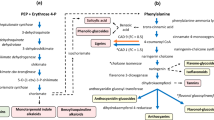Abstract
Isoprene emission is related to photosynthesis but the nature of the relationship is not yet known. To explore this relationship we have examined the rate of isoprene emission, photosynthesis, and the contents of photosynthetic metabolites in leaves of velvet bean (Mucuna deeringeniana L.) and red oak (Quercus rubra L.) in response to a light-to-dark transition and to changes in air composition. Isoprene emission fell when darkness was imposed and the drop was associated with reduced amounts of ribulose-1,5-bisphosphate and ATP. The rate of isoprene emission and ATP content were reduced to the same extent by exposure to low O2 or high CO2 partial pressures. Only when O2 and CO2 were simultaneously removed from the air did the rate of isoprene emission drop without a corresponding change in ATP. The results demonstrate that when carbon is not limiting, isoprene emission is highly correlated with ATP content. When synthesis of phosphoglyceric acid is inhibited, however, carbon availability may control isoprene production.
Similar content being viewed by others
Abbreviations
- FBP:
-
fructose 1,6-bisphosphate
- Fru6P:
-
fructose 6-phosphate
- Glc6P:
-
glucose 6-phosphate
- PGA:
-
3-phosphoglyceric acid
- RuBP:
-
ribulose 1,5-bisphosphate
- Rubisco:
-
RuBP carboxylase-oxygenase
References
Andrews, T.J., Kane, H.J. (1991) Pyruvate is a by-product of catalysis by ribulosebisphosphate carboxylase/oxygenase. J. Biol. Chem. 266, 9447–9452
Badger, M.R., Sharkey, T.D., Von Caemmerer, S. (1984) The relationship between steady-state gas exchange of bean leaves and the levels of carbon-reduction-cycle intermediates. Planta 160, 305–313
Brooks, A., Portis, A.R., Jr., Sharkey, T.D. (1988) Effects of irradiance and methyl viologen treatment on ATP, ADP and activation of ribulose bisphosphate carboxylase in spinach leaves. Plant Physiol. 88, 850–853
Hoagland, D.R, Arnon, D.I. (1938) The water culture method for growing plants without soil, pp. 1–39, Berkeley: UC Agric. Exp. Sta. Circ. No 347
Jones, C.A., Rasmussen, R.A. (1975) Production of isoprene by leaf tissue. Plant Physiol. 55, 982–987
Loreto, F., Sharkey, T.D. (1990) A gas-exchange study of photosynthesis and isoprene emission in Quercus rubra L. Planta 182, 523–531
Lowry, O.H., Passonneau, J.V. (1972) A flexible system of enzymatic analysis, pp. 1–291, Academic Press, Orlando
Monson, R.K., Fall, R. (1989) Isoprene emission from Aspen leaves. The influence of environment and relation to photosynthesis and photorespiration. Plant Physiol. 90, 267–274
Monson, R.K., Hills, A.J., Zimmerman, P.R., Fall, R.R. (1991) Studies of the relationship between isoprene emission rate and CO2 or photon-flux density using a real-time isoprene analyser. Plant Cell Environ. 14, 517–523
Sanadze, G.A. (1990) The principle scheme of photosynthetic carbon conversion in cells of isoprene releasing plants. Cur. Res. Photosyn. IV, 231–237
Sanadze, G.A., Kursanov, A.L. (1966) On certain conditions of the evolution of the diene C5H8 from poplar leaves. Sov. Plant Physiol. 13, 184–189
Sharkey, T.D., Stitt, M., Heineke, D., Gerhardt, R., Raschke, K., Heldt, H.W. (1986) Limitation of photosynthesis by carbon metabolism. II O2 insensitive CO2 uptake results from limitation of triose phosphate utilization. Plant Physiol. 81, 1123–1129
Sharkey, T.D., Loreto, F., Delwiche, C.F. (1991) The biochemistry of isoprene emission from leaves during photosynthesis. In: Trace gas emissions from plants, pp. 153–184, Sharkey, T.D., Holland, E.A., Mooney, H.A., eds. Academic Press, San Diego
Silver, G.M., Fall, R. (1991) Enzymatic synthesis of isoprene from dimethylallyl diphosphate in aspen leaf extracts. Plant Physiol. 97, 1588–1591
Socias, F.X., Medrano, H., Sharkey, T.D. (1992) Feedback limitation of photosynthesis of Phaseolus vulgaris L. grown in elevated CO2. Plant Cell Environ., in press
Tingey, D.T., Manning, M., Grothaus, L.C., Burns, W.F. (1979) The influence of light and temperature on isoprene emission rates from live oak. Physiol. Plant. 47, 112–118
Tingey, D.T., Evans, R., Gumpertz, M. (1981) Effects of environmental conditions on isoprene emission from live oak. Planta 152, 565–570
von Caemmerer, S., Farquhar, G.D. (1981) Some relationships between the biochemistry of photosynthesis and the gas exchange of leaves. Planta 153, 376–387
Author information
Authors and Affiliations
Additional information
Mr. Peter Vanderveer assisted with the measurements of enzymatic metabolites. Mr. Xavier Socias is gratefully acknowledged for Rubisco preparation. This research was supported by the U.S. National Science Foundation, grant no. IBN 9105274.
Rights and permissions
About this article
Cite this article
Loreto, F., Sharkey, T.D. On the relationship between isoprene emission and photosynthetic metabolites under different environmental conditions. Planta 189, 420–424 (1993). https://doi.org/10.1007/BF00194440
Accepted:
Issue Date:
DOI: https://doi.org/10.1007/BF00194440




